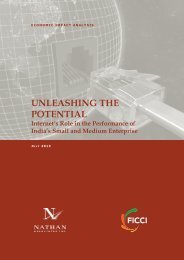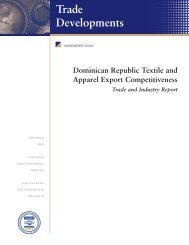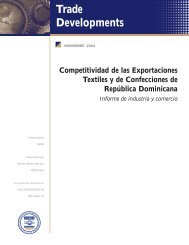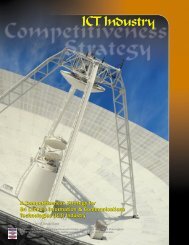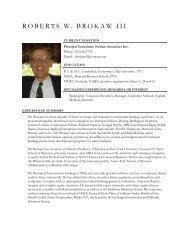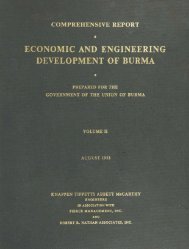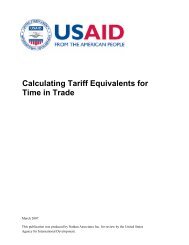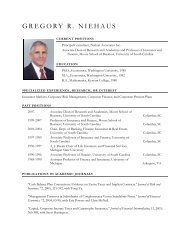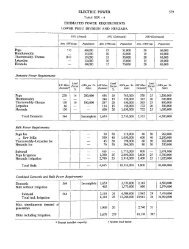Putting it to Work in Developing Countries - Nathan Associates
Putting it to Work in Developing Countries - Nathan Associates
Putting it to Work in Developing Countries - Nathan Associates
Create successful ePaper yourself
Turn your PDF publications into a flip-book with our unique Google optimized e-Paper software.
FDI <strong>in</strong>flows also fell <strong>in</strong> develop<strong>in</strong>g countries,<br />
but only by 10 percent from the 1999 peak of<br />
$187 billion and <strong>to</strong> $169 billion <strong>in</strong> 2003. The<br />
decl<strong>in</strong>e appears <strong>to</strong> have been largely a function<br />
of a dry<strong>in</strong>g up of FDI <strong>to</strong> middle-<strong>in</strong>come<br />
economies, particularly <strong>in</strong> Lat<strong>in</strong> America and<br />
South East Asia, as developed country mult<strong>in</strong>ationals<br />
retrenched; privatizations were concluded<br />
<strong>in</strong> the <strong>in</strong>frastructure, petroleum, and f<strong>in</strong>ancial<br />
sec<strong>to</strong>rs; and <strong>in</strong>terest <strong>in</strong> cross-border mergers and<br />
acquis<strong>it</strong>ions waned <strong>in</strong> the face of f<strong>in</strong>ancial crises<br />
<strong>in</strong> both regions.<br />
In other parts of the develop<strong>in</strong>g world, <strong>in</strong>clud<strong>in</strong>g<br />
the low-<strong>in</strong>come countries as a group, FDI<br />
<strong>in</strong>flows rema<strong>in</strong>ed stable or <strong>in</strong>creased slightly<br />
between 1999 and 2003. Ch<strong>in</strong>a and India,<br />
where <strong>in</strong>flows cont<strong>in</strong>ued <strong>to</strong> rise after 1999, were<br />
major fac<strong>to</strong>rs <strong>in</strong> this pattern.<br />
2004–2005 RETURN TO GROWTH<br />
After a four-year slump, FDI <strong>in</strong>flows <strong>to</strong> the<br />
develop<strong>in</strong>g world began <strong>to</strong> rise substantially.<br />
Growth <strong>in</strong> 2004 and 2005 has been dramatic—<br />
69 percent from the 2003 trough. Total FDI<br />
<strong>in</strong>flows now stand at $285 billion, a new record<br />
for the develop<strong>in</strong>g world. FDI activ<strong>it</strong>y also<br />
reign<strong>it</strong>ed and expanded <strong>in</strong> developed countries,<br />
though <strong>to</strong> levels considerably below the peak<br />
<strong>in</strong>flows of 2000.<br />
Reasons for this turnaround are clear. Economic<br />
growth <strong>in</strong> the developed world, first <strong>in</strong> the<br />
Un<strong>it</strong>ed States and then <strong>in</strong> the European Union<br />
and Japan, produced major ga<strong>in</strong>s <strong>in</strong> developed<br />
country s<strong>to</strong>ck markets and susta<strong>in</strong>ed <strong>in</strong>creases <strong>in</strong><br />
corporate prof<strong>it</strong>s. This generated FDI activ<strong>it</strong>y<br />
worldwide. Much of the global <strong>in</strong>crease <strong>in</strong> FDI<br />
<strong>to</strong>ok the form of large-scale cross-border M&A<br />
transactions by mult<strong>in</strong>ationals, particularly—but<br />
not exclusively—w<strong>it</strong>h<strong>in</strong> the developed world.<br />
Similarly, <strong>in</strong> the develop<strong>in</strong>g world, macroeconomic<br />
cond<strong>it</strong>ions have been favorable, w<strong>it</strong>h economic<br />
growth annually averag<strong>in</strong>g 6 percent <strong>to</strong> 7<br />
percent <strong>in</strong> real terms. 3 Economic expansion has<br />
been particularly robust <strong>in</strong> Ch<strong>in</strong>a (9.9 percent)<br />
and India (8 percent). Cont<strong>in</strong>u<strong>in</strong>g bus<strong>in</strong>ess environment<br />
liberalization and policy reform, vigorous<br />
global trade expansion (10.6 percent <strong>in</strong><br />
2004 and 7.1 percent <strong>in</strong> 2005), and boom<strong>in</strong>g<br />
commod<strong>it</strong>y prices, especially for oil (up 30.6<br />
percent <strong>in</strong> 2004 and 41.5 percent <strong>in</strong> 2005), all<br />
fuel this growth. Ris<strong>in</strong>g corporate prof<strong>it</strong>s and<br />
s<strong>to</strong>ck markets <strong>in</strong> develop<strong>in</strong>g countries also contributed<br />
<strong>to</strong> the new flow of FDI deals.<br />
MEDIUM-TERM PROSPECTS<br />
For the rest of this decade develop<strong>in</strong>g countries<br />
as a group are likely <strong>to</strong> ma<strong>in</strong>ta<strong>in</strong> the present<br />
record volumes of FDI <strong>in</strong>flows. 4 But the pace of<br />
growth may level off. Accord<strong>in</strong>g <strong>to</strong> a mediumterm<br />
forecast by the Economist Intelligence<br />
Un<strong>it</strong>, <strong>to</strong>tal FDI <strong>in</strong>flows <strong>to</strong> develop<strong>in</strong>g countries<br />
reached a new peak <strong>in</strong> 2005 and will now rise<br />
by only about 7 percent by 2010, a far cry from<br />
the trajec<strong>to</strong>ry of the past two years. Some develop<strong>in</strong>g<br />
economies will certa<strong>in</strong>ly do much better<br />
than this (e.g., Ch<strong>in</strong>a, a global manufactur<strong>in</strong>g<br />
export platform, and India, a world leader <strong>in</strong> IT<br />
services exports, and both also attractive for<br />
their mass domestic markets).<br />
The fac<strong>to</strong>rs favor<strong>in</strong>g current susta<strong>in</strong>ed high levels<br />
of FDI <strong>in</strong>flow for the rest of the decade<br />
appear <strong>to</strong> be the same ones that generated the<br />
recent reversal: cont<strong>in</strong>u<strong>in</strong>g global economic<br />
recovery and robust trade expansion, strong<br />
demand for key commod<strong>it</strong>ies, progress <strong>in</strong> liberaliz<strong>in</strong>g<br />
markets and <strong>in</strong>vestment climates, and<br />
worldwide compet<strong>it</strong>ive pressures <strong>to</strong> achieve cost<br />
efficiency. Mult<strong>in</strong>ationals’ <strong>in</strong>terest <strong>in</strong> cross-border<br />
M&As <strong>in</strong> the develop<strong>in</strong>g and developed<br />
worlds, and ample f<strong>in</strong>ancial liquid<strong>it</strong>y for such<br />
activ<strong>it</strong>y, will also susta<strong>in</strong> <strong>in</strong>flows. A cont<strong>in</strong>u<strong>in</strong>g<br />
shift <strong>to</strong>ward FDI <strong>in</strong> services, where cross-border<br />
<strong>in</strong>vestment opportun<strong>it</strong>ies may still be untapped<br />
and where various develop<strong>in</strong>g countries may<br />
seek <strong>to</strong> attract FDI <strong>to</strong> upgrade <strong>in</strong>frastructure<br />
standards, will be important <strong>to</strong> support M&A<br />
activ<strong>it</strong>y.<br />
Of course, prospective FDI flows face risks.<br />
Economic nationalism and protectionism seem<br />
<strong>to</strong> be ga<strong>in</strong><strong>in</strong>g strength <strong>in</strong> the developed and<br />
develop<strong>in</strong>g world alike, and might beg<strong>in</strong> <strong>to</strong><br />
26



